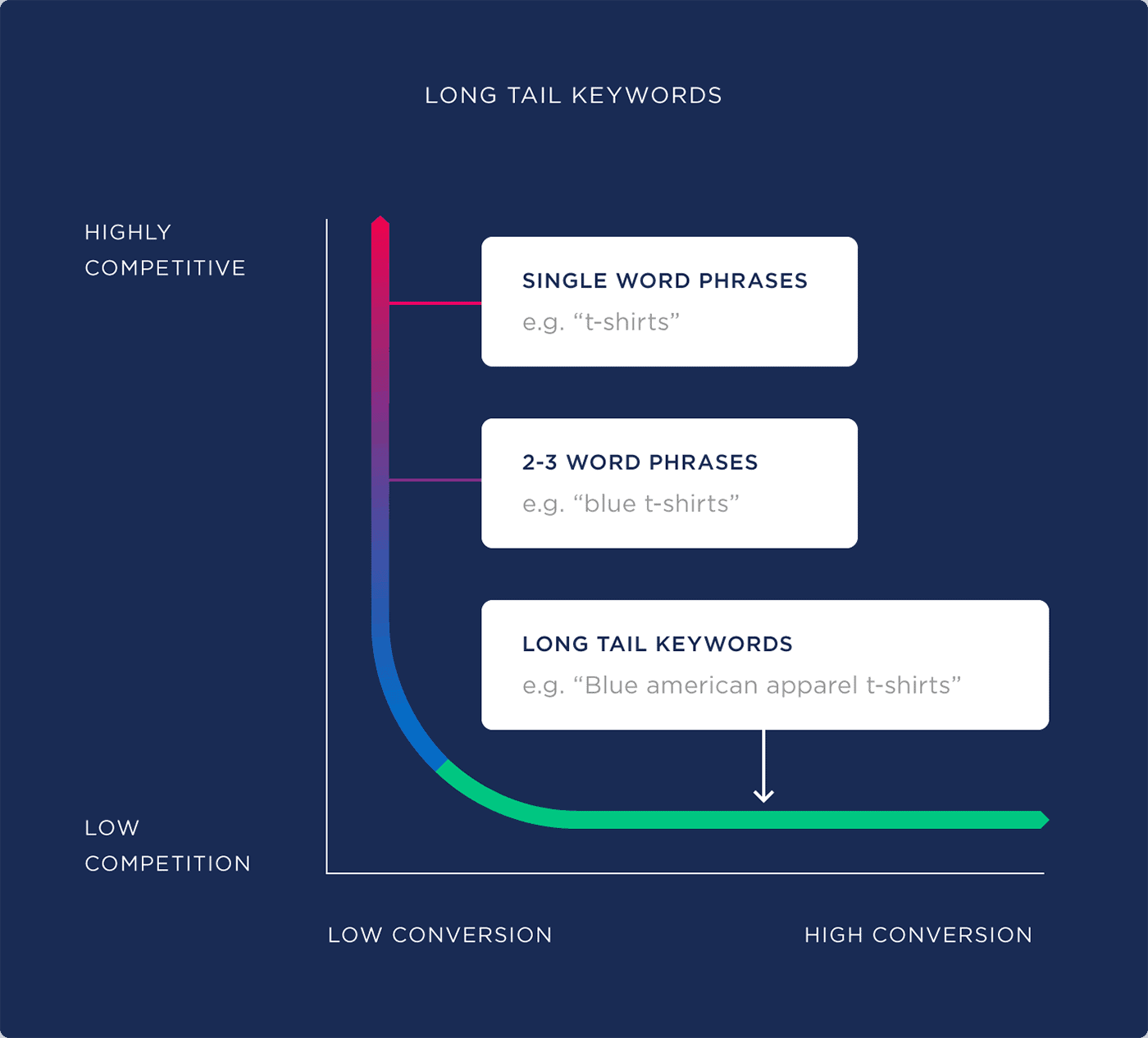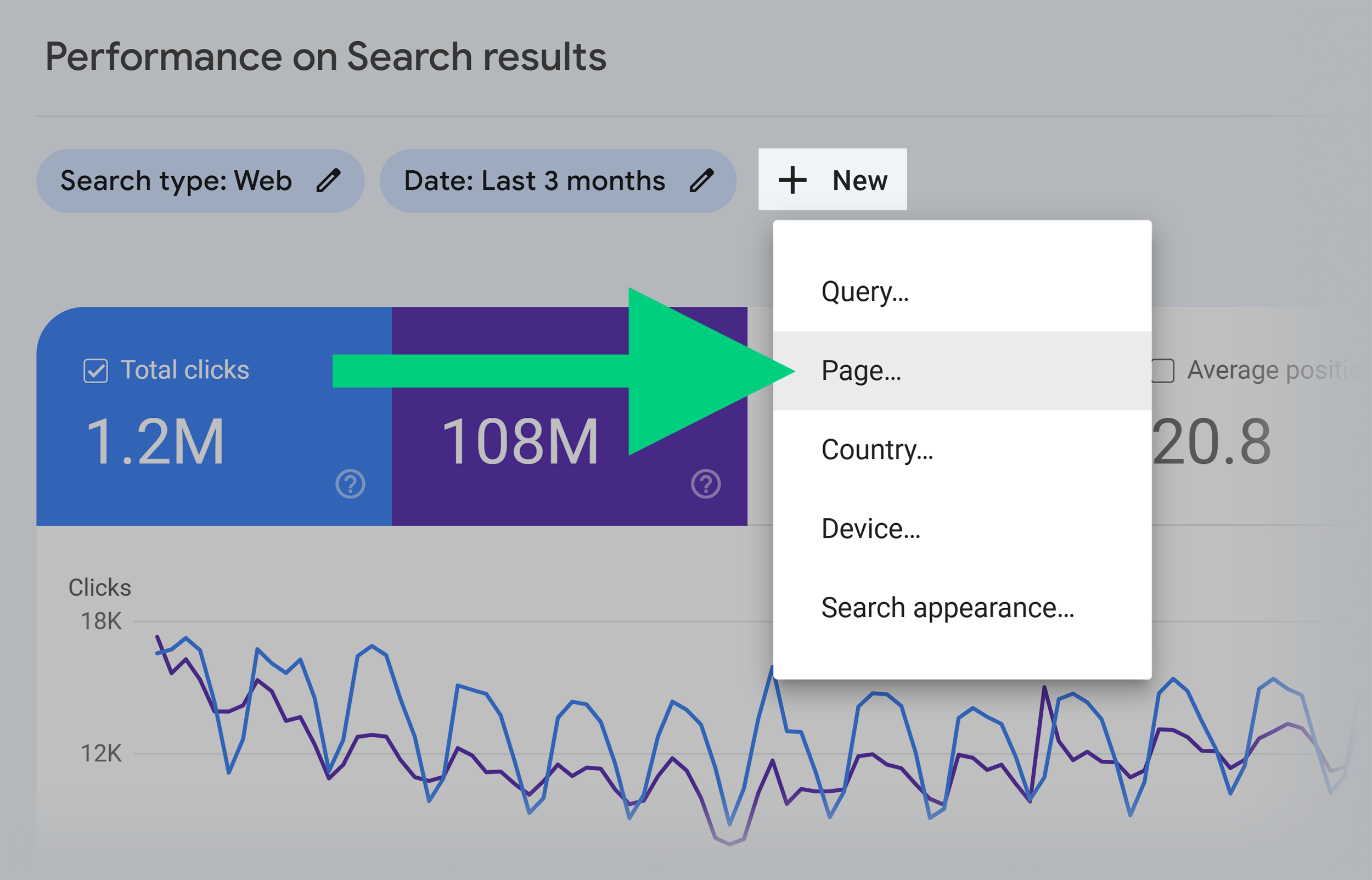10 Types of Keywords with Examples (+ How to Find Them)

Written by Backlinko Team

In this post, you’ll learn the 10 most important types of keywords to improve your SEO.
| Keyword Type | Examples |
|---|---|
| 1. Seed keywords | Books, cars, digital marketing |
| 2. Informational keywords | How to change a tire, what is SEO |
| 3. Commercial keywords | Best CRM software, compare MacBooks |
| 4. Transactional keywords | Book a hotel room, buy Nike shoes |
| 5. Navigational keywords | Youtube login, Facebook |
| 6. Long Tail keywords | Slow Wi-Fi connection on MacBook Pro |
| 7. Short Tail keywords | Off-page SEO, gardening tips |
| 8. Primary keywords | Healthy recipes |
| 9. Secondary keywords | “Healthy dinner recipes” for a page about healthy recipes |
| 10. Geotargeted keywords | Vinyl record store in New York |
We’ll show you how these types of keywords can help shape your SEO strategy. So that your content attracts more visitors to your website.
Let’s get started.
1. Seed Keywords
Seed keywords are short and generic words or phrases related to your business.
While you may target seed keywords directly, they’re really the starting point for your later keyword research efforts. They typically have high search volumes and high competition.
How to Find Seed Keywords
To come up with your own seed keywords, think about the core aspects of your business, industry, product, or service. And brainstorm ideas you can use as starting points to find more keywords.
For example, if you’re a mechanic with your own garage, you might come up with the following seed keywords:
- Mechanic
- Garage
- Auto repair
- Tire fitting
- Windshields
You can also use keyword tools to find more seed keywords.
For example, imagine you sold bullet journals and wanted to use content marketing to drive more traffic to your online store.
You could use Answer The Public to get lots of seed keyword ideas for further keyword research.

Or use Semrush’s Keyword Magic Tool, filtering for keywords containing just 1-2 words.

Why It’s Important to Choose the Right Seed Keywords
Seed keywords are typically the starting point of your keyword research efforts. So you want to choose ones that are relevant to what you offer.
Otherwise, you might end up targeting lots of irrelevant keywords later down the line.
2. Informational Keywords
Informational keywords are queries people search for when their goal is to learn or understand something.
When you optimize content for informational keywords, you’re typically answering questions, providing instructions, or educating readers on a particular topic.
Here are a few examples of informational keywords:
- Places to visit in Europe
- How to clean an acoustic guitar
- How does inflation work?
- Pros and cons of vegan diets
- Matcha tea benefits

How to Find Informational Keywords
To quickly find lots of informational keywords related to your online business, use Semrush’s Keyword Magic Tool.
Enter your seed keyword and hit “Search.”

Then, filter the results to see informational keywords based on search intent.
Choose the “Informational” filter under the “Intent” category and click “Apply.”

Why You Should Target Informational Keywords
Even though informational keywords don’t always lead to immediate sales, they can help you nurture leads in the early stages of their buying journeys.
Think of informational keywords as an entry point to your marketing funnel. Where you build awareness of your brand and solutions.

Targeting informational keywords can attract a broader audience from organic (unpaid) search. People who might not have even known about your brand before.
And so creating content around informational keywords is a great way to show potential customers they can trust you. As you have the answers to their questions.
Plus, with great content and well-placed calls to action (CTAs), you can still convert readers into customers with informational content.
3. Commercial Keywords
Users search for commercial keywords when they’re researching products, services, or brands. The user is fairly close to making a purchase, making these valuable keywords to target.
Here are a few examples of commercial keywords:
- Budget smartphones under $300
- Top-rated blenders for smoothies
- Semrush review
- Cheapest flights to London
- Best vinyl albums for audiophiles

How to Find Commercial Keywords
Commercial keywords often contain words like:
- Best
- Cheapest
- Top-rated
- Review
- Compare
You can therefore quite easily come up with your own commercial keywords related to your offerings. Just by adding some of these words to your seed keywords.
Like:
- Best bullet journal (4.3K global monthly search volume)
- Compare car insurance (205K global monthly search volume)
- Cheapest email marketing software (1.1K monthly search volume)
Why Commercial Keywords Are Important
Commercial keywords can help you attract high-quality prospects who are almost ready to buy.
Depending on your target keyword, you can create content that speaks directly to their needs. Like comparison listicles that demonstrate the features of your product or service compared to your competitors.
Or product reviews and testimonial pages from existing customers.
These types of content can help you turn interested users into paying customers.
4. Transactional Keywords
Transactional keywords are search terms that indicate a user’s intent to take a specific action. This could be buying a product or signing up for a service.
Here are a few examples of transactional keywords:
- Order birthday flowers online
- Price of Samsung Galaxy Watch 5
- Used cars for sale
- Trial guitar lessons online
- Buy iPhone 15

How to Find Transactional Keywords
To create transactional keywords, you can simply add the following words to the keywords related to your business:
- Action words: Like buy, order, subscribe, download, free trial, quote
- Price-related terms: Like discount, sale, price, coupon, affordable
For example, if you sell t-shirts online, “buy bullet journal” or “bullet journals on sale” could be viable transactional keywords. Although they’re highly generic, and likely to be super competitive.
A better approach would be to use the Keyword Magic Tool to generate a bunch of transactional keywords related to your seed keyword.

For example, this reveals there could be opportunities to create content about (and sell) bullet journal templates and apps.
Why Transactional Keywords Are Valuable
Transactional keywords indicate users at the bottom of the sales funnel with the highest intent to buy.

They have already gathered all the required information, compared available options, and are now ready to buy (ideally from you).
This makes transactional keywords some of the most valuable ones to target.
5. Navigational Keywords
Navigational types of keywords are search terms people use to find specific websites or webpages.
These keywords often include the name of a company and/or detail about the page the user would like to find.
Here are a few examples of navigational keywords:
- Amazon login
- Backlinko blog
- DogTuff beds

How to Find Navigational Keywords
You can use the Keyword Magic Tool to research and analyze all navigational keywords relevant to your online business in your target location.
Just plug in your brand as a keyword and change the intent to “Navigational.”

Should You Target Navigational Keywords?
Searchers use navigational keywords when they already know where they want to go. Making them quite unique from the types of keywords we’ve discussed already.
This also means that they’re quite tough to target unless your site is where they want to go. You wouldn’t target “Nike homepage” if you weren’t Nike, for example.
However, ranking for navigational keywords related to your brand ensures users can easily find what they need. So they’re still worth researching and optimizing for.
6. Long Tail Keywords
Long tail keywords are specific, multi-word phrases (usually 3+ words).
Because these terms are specific, they usually have lower search volumes and lower levels of competition than your seed keywords, for example.
Here are a few examples of long tail keywords:
- Thai restaurant with vegetarian options
- At-home exercises for strengthening knees
- How to grow organic vegetables in small balcony gardens
- How to play the guitar for left-handed people
- Fun indoor activities for kids

There’s a fair bit of overlap between long tail and informational keywords. As many people looking to learn more about specific things will naturally search for longer terms.
But long tail keywords can overlap with other types of keywords too.
In the image below, you’ll see long-tail transactional keywords. And you’ll notice that longer keywords with lower levels of competition can have higher conversion potential.

Making them quite lucrative keywords to target.
How to Find Long Tail Keywords
Google’s autocomplete feature is a great way to find long tail keywords related to your seed keyword.
Just start typing your seed keyword or content topic, and it’ll show a drop-down list of users’ search terms.

Why You Should Use Long Tail Keywords
Long tail keywords have specific intent and can attract users who may be more likely to convert into customers.
For example, these users are more likely to take action on your website. Like making a purchase or signing up for a newsletter.
Long tail keywords are also often less competitive, which can make it easier to rank higher.
For example, look at the keyword difficulty of a term like “how to create a bullet journal”:

Compared to “bullet journaling”:

This is why you should consider starting with long tail keywords if you’re a new website owner. You can rank far quicker for these less competitive terms. Even if they do tend to have much lower search volumes.
7. Short Tail Keywords
Short tail keywords are short, generic keywords. Usually 1-3 words long.
They’re a bit like seed keywords, and they typically have relatively high search volume and high levels of competition. But generally a low conversion rate.
Here are a few examples of short tail keywords:
- Rock music
- Vegan recipes
- Running shoes
- Digital marketing
- On-page SEO
They’re usually pretty tough to rank for.

If your website is new or has a low level of authority, chances are some stronger competitors will outperform it in search results for these terms.
How to Find Short Tail Keywords
You can find short tail keywords using many of the methods we’ve already discussed. Like entering your seed keyword into Google search and seeing what it suggests:

Or using a tool like Answer the Public to find other short terms:

Why Use Short Tail Keywords
If short tail keywords are difficult to target, why bother?
Firstly, because you can use short tail keywords as seed keywords during the first phase of your keyword research. Which we know from earlier is important on its own.
Secondly, you can target them with hub or category pages. Which then contain links to other pieces of more specific content.
Like all of these sites that currently rank for “vegan recipes”:

Now, it’s important to note that these are big, authoritative websites. And this is a competitive term:

So ranking for short tail keywords in this way isn’t going to be easy for newbies.
But they can be incredibly lucrative later down the line as your authority grows.
8. Primary Keywords
Your primary keyword is the main term you want your page or website to rank for in search results.
When you include your primary keyword throughout your content, it helps tell Google and other search engines what the page is about.
Here are a few examples of primary keywords:
- Hiking trails near Yosemite
- Eco-friendly cleaning products
- Healthy dinner recipes
- Guitar playing tips
- How to write a cover letter

Which you could then create pieces of content for. And include the primary keyword throughout.
For example, in the image below, the “SEO checklist” keyword is strategically placed throughout the content, from the URL slug to the H1 tag.

This helps Google (and users) understand what the page is about. And it helps this page rank top for its primary keyword:

How to Find Primary Keywords
You can find primary keywords through a variety of keyword research methods. As always, you can turn to Google’s search results features to help you.
Like the people also ask:

And the related searches section:

Or you can use a keyword tool:

But no matter which method you choose, aim for ones with:
- Decent monthly search volume
- Business value to attract potential customers (i.e., target some with commercial or transactional search intent)
- Fairly low levels of competition (at least when your site is still new)
Why Primary Keywords Are Vital
Using primary keywords in your writing helps search engines match your content with relevant search queries. This makes your webpage more likely to appear in relevant search results, where your target audience will see it.
As a general rule, use one primary keyword for each page you create to keep things clear for search engines (and users).
But you can target multiple secondary keywords within your content (see below).
9. Secondary Keywords
Secondary keywords are terms related to your primary keyword. Usually these make up the subtopics of your pages.
If a primary keyword is a broad topic, like “what is email marketing,” then secondary keywords go deeper and cover related searches with lower competition. Like “how to start email marketing” and “tips for email marketing.”
How to Find Secondary Keywords
Finding secondary keywords is easy if you already know your primary keyword. You can probably brainstorm ideas fairly quickly, or use Google search to help you.
Just look at the “People also ask” part of the search results:

And the “People also search for” section:

For even more ideas, open the “Related” report in the Keyword Magic Tool for your primary keyword.
To narrow things down a bit, add a keyword difficulty filter. Going for a custom range of 0-49 covers all keywords marked “Possible” or easier to rank for.

Google can rank your webpage for many related keywords, even if you don’t directly mention them.
In fact, you probably already rank for keywords you’re not targeting. And you can find these terms in Google Search Console.
Click on the “Search results” report in the “Performance” menu.

This report shows all the keywords your website currently receives impressions for in Google search results.
Click “+New” and Select “Page” from the drop-down menu.

Choose “Exact URL,” paste the URL of the page you want to find secondary keywords for, and click “Apply.”

Now, scroll down to see what keywords your page currently ranks for.
Filter the keywords by impressions to see which ones your page often appears in search results for. But only gets a few (or zero) clicks.

Let’s say your article ranks for “automated SEO tools” but doesn’t mention that exact phrase.
Since users search for this term, consider adding this keyword to the content where relevant. This could potentially improve your search rankings for that keyword.
Why Secondary Keywords Matter
Using secondary keywords shows Google and users that you understand the subtopics that surround your main keyword’s core topic. And they can help you rank your content for many keywords. Not just your primary term.
While they might be low-volume search terms, using a combination of secondary keywords can attract a good amount of traffic to your pages.
To help search engines better understand your content (and potentially lead to higher rankings), include your primary keyword in the title and use secondary keywords throughout the subheadings and body text.
Using these to guide you on the topics to discuss.

10. Geotargeted Keywords
Geotargeted or local keywords are search terms that include a location, such as a country, city, or neighborhood. Or a term like “near me.”
Using these keywords in your content can help attract users looking for what you offer in your particular area.
Here are a few examples of geotargeted keywords:
- Live music events in Austin
- Italian restaurants in Los Angeles
- Emergency dentist Chicago
- Farmers markets near me
- Matcha coffee shop New York

Geotargeted keywords are a crucial aspect of local SEO.
How to Find Geotargeted Keywords
You can quickly find relevant local keywords with Semrush’s Keyword Magic Tool by applying filters to your seed keyword to view local keywords only.
For example, add your target city to the “Include Keywords” filter to see only relevant keywords.

Or you can check the viability of keywords in your target area by entering them into the Keyword Overview tool. And choosing your target location.

Why You Should Use Geotargeted Keywords
Using geotargeted keywords in your content can help connect your business with customers searching nearby.
Users searching for local terms are often out and about in that area. Looking for solutions to a problem they’re having right now.
This means they’re often close to making a purchase. And as with the transactional keywords we discussed earlier, this makes them very lucrative.
Use the Right Types of Keywords for Your Business
If you want to expand your business online and make more sales, you need to target the right types of keywords.
For more guidance on doing just that, check out this guide to choosing keywords for SEO.
And for more great keyword ideas, check out Backlinko’s free keyword research tool.